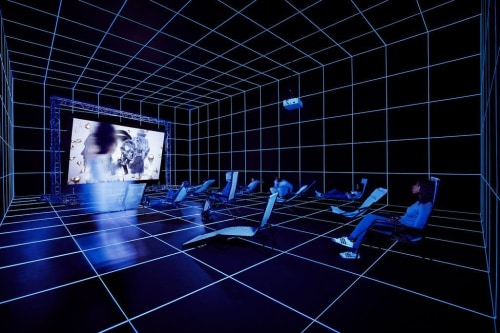
Hito Steyerl’s “Factory of the Sun” (2015), in which viewers sit on lounge chairs in a gridded space to watch a video game parody. Courtesy of the artist and Andrew Kreps Gallery, New York; Photograph by Sarah Wilmer
By MIKE HALE
OCT. 26, 2016
The New York Times
When we talk about technology and the movies these days, we’re often talking about the movies becoming smaller. They can be shot on GoPros and cellphones, then watched on laptops, tablets and those same cellphones. Access to the means of production grows while the artistic product shrinks. In the future, the moving image fits in your palm, a tidy, flat display held a few inches from your face.
“Dreamlands: Immersive Cinema and Art, 1905-2016,” opening on Friday at the Whitney Museum of American Art, takes the argument in the opposite direction. It’s about the expansive possibilities of the digital age, the new ways the motion picture — traditionally two-dimensional in both visual and, the show argues, narrative terms — can be an immersive, multidimensional experience, perceptually, physically and conceptually.
This sprawling exhibition, curated by Chrissie Iles, is the first film-centered show in the Whitney’s new meatpacking-district building. Ranging far beyond straightforward cinema, it will fill the museum’s fifth floor with projections, installations and artwork. Ben Coonley’s 3-D 360-degree video “Trading Futures” will be projected on the inside of a geodesic dome. Alex Da Corte and Jayson Musson’s installation “Easternsports” includes video projected onto four facing screens in a synesthetic whole along with sound, light, décor and the smell of oranges. There will be displays of concept art for visually inventive films like “Fantasia” and “Blade Runner.”
That might sound like heavy going for the average film buff, and a lot of visitors might not get very far in Ms. Iles’s catalog essay, with its references to pluralistic models of visuality and transplanar images. But the show, and its accompanying film series, should function just as well as a concentrated and accessible celebration of experimental film in general — one that, like the works themselves, has broken free, in this case from the biennials and film archives where avant-garde work is usually confined.
Some of the most appealing entries in the exhibition are distinctly predigital and, by current standards, low-tech. The show includes works dating to the 1910s, a recognition that moving image technology has always been turned on itself to critique and transcend technology. This section includes drawings and watercolors from Disney’s “Fantasia” (1940) and what promises to be a dramatic installation of Bruce Conner’s A-bomb montage “Crossroads” (1976) — a pair of wildly different but equally immersive experiences.
Perhaps the most exciting of the show’s historical items is the artist Joseph Cornell’s 19-minute film poem “Rose Hobart” (1936), a condensation of a 1931 B picture called “East of Borneo,” in which Cornell spliced together all the scenes featuring Hobart, the film’s star, and replaced the soundtrack with Brazilian songs. The result is a shimmering reverie that seems to find an elemental romantic impulse hidden inside the Hollywood product. And in its cut-and-paste collage technique, it anticipates the sort of fan tributes that would find a home on YouTube decades later.
Moving to the present, the work becomes more fragmented and self-consciously conceptual, but there are still pure pleasures to be had. Hito Steyerl’s “Factory of the Sun,” shown at the 2015 Venice Biennale, is an enveloping installation in which viewers sit on lounge chairs in a gridded, “Tron”-like space to watch an engaging disco-science-fiction parody of a video game.
The show will gather, for the first time in New York, all the videos from Pierre Huyghe and Philippe Parreno’s “Annlee” project, in which the artists “liberated” a manga character from corporate servitude by buying her rights (for about $400) and not only using her in their own work but also offering her to other artists. Ms. Iles draws a line from Maria, the gleaming cyborg of Fritz Lang’s “Metropolis,” through Hobart, the dancing brooms of “Fantasia” and the replicants of “Blade Runner” to the aurora-eyed Annlee, who laments that she’s “just a shell.”
Past and present meet in Mathias Polenda’s “Imitation of Life” (2013), a hand-drawn short in which a team of former Disney animators created a simulacrum of a classic Disney cartoon that’s note perfect and, because of that, unsettling. Things are just a little too perfect in the film’s sylvan forest, where a sailor-suited donkey does a soft-shoe and sings Arthur Freed and Nacio Herb Brown’s “I’ve Got a Feelin’ You’re Foolin’.”
In the world outside the museum, the shrinking of the moving-image experience may seem inexorable — just days ago, AT&T justified its $85 billion bid for Time Warner by declaring that mobile video is the future of all media. “Dreamlands” demonstrates that there remains a space where it doesn’t have to be that way.